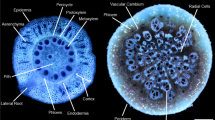Abstract
Soil nutrients, and factors which influence their concentrations and bioavailability, form a basic component of bottom–up control of ecosystem processes, including plant–herbivore interactions. Increased nutrient levels are linked, through plant defence theory, with increased levels of herbivore susceptibility. The focal point of many ecological experiments examining this link is at the species level, where the response of single species is the average of many different genotypes. Here, we focus on the genetic basis of indirect ecological interactions. We investigated the effects of nutrient concentration on the population growth of an aphid herbivore across multiple genotypes of barley in relation to plant growth rate. In general, both aphid population size and plant growth rate increased with nutrient concentration. However, they were both dependent on the interaction between nutrient concentration and barley genotype. Our data raise the testable possibility of differential defense responses between genotypes of barley, for example divergent, fixed and inducible defences against aphids. We provide evidence that the indirect effects of soil nutrients on aphid population size are mediated by the genetics of the host plant.



Similar content being viewed by others
References
Astles PA, Moore AJ, Preziosi RF (2005) Genetic variation in response to an indirect ecological effect. Proc R Soc Lond B 272:2577–2581
Bethke JA, Redak RA, Schuch UK (1998) Melon aphid performance on chrysanthemum as mediated by cultivar, and differential levels of fertilization and irrigation. Entomol Exp Appl 88:41–47
Bryant JP, Chapin FS, Klein DR (1983) Carbon nutrient balance of boreal plants in relation to vertebrate herbivory. Oikos 40:357–368
Casaretto JA, Corcuera LJ (1998) Proteinase inhibitor accumulation in aphid-infested barley leaves. Phytochemistry 49:2279–2286
Chau A, Heinz KM, Davies FT (2005) Influences of fertilization on Aphis gossypii and insecticide usage. J Appl Entomol 129:89–97
Coley PD, Bryant JP, Chapin FS (1985) Resource availability and plant antiherbivore defense. Science 230:895–899
Corcuera LJ (1993) Biochemical basis for the resistance of barley to aphids. Phytochemistry 33:741–747
Dyer LA, Stireman JO (2003) Community-wide trophic cascades and other indirect interactions in an agricultural community. Basic Appl Ecol 4:423–432
Fajer ED, Bowers MD, Bazzaz FA (1992) The effect of nutrients and enriched CO2 environments on production of carbon-based allelochemicals in Plantago—a test of the carbon nutrient balance hypothesis. Am Nat 140:707–723
Glynn C, Herms DA, Egawa M, Hansen R, Mattson WJ (2003) Effects of nutrient availability on biomass allocation as well as constitutive and rapid induced herbivore resistance in poplar. Oikos 101:385–397
Hendriks RJJ, Luijten L, van Groenendael JM (2009) Context-dependent defence in terrestrial plants: the effects of light and nutrient availability on plant resistance against herbivory. Entomol Exp Appl 131:233–242
Herms DA, Mattson WJ (1992) The dilemma of plants—to grow or defend. Q Rev Biol 67:283–335
Mitchell SE, Rogers ES, Little TJ, Read AF (2005) Host–parasite and genotype-by-environment interactions: temperature modifies potential for selection by a sterilizing pathogen. Evolution 59:70–80
Oerke E-C (1994) Estimated crop losses due to pathogens, animal pests and weeds. In: Oerke E-C, Dehne H-W, Schönbeck F, Weber A (eds) Crop production and crop protection: estimated losses in major food and cash crops. Elsevier, Amsterdam, pp 72–741
Orians CM, Fritz RS (1996) Genetic and soil-nutrient effects on the abundance of herbivores on willow. Oecologia 105:388–396
Reusch TBH, Ehlers A, Hammerli A, Worm B (2005) Ecosystem recovery after climatic extremes enhanced by genotypic diversity. Proc Natl Acad Sci USA 102:2826–2831
Stamp N (2003) Out of the quagmire of plant defense hypotheses. Q Rev Biol 78:23–55
Tétard-Jones C, Kertesz MA, Gallois P, Preziosi RF (2007) Genotype-by-genotype interactions modified by a third species in a plant–insect system. Am Nat 170:492–499
Velozo JA, Alvarez RI, Wachter GA, Timmermann BN, Corcuera LJ (1999) Increase in gramine content in barley infested by the aphid Schizaphis graminum R. Phytochemistry 52:1059–1061
Whitham TG et al (2006) A framework for community and ecosystem genetics: from genes to ecosystems. Nat Rev Genet 7:510–523
Whitlock R, Grime JP, Booth R, Burke T (2007) The role of genotypic diversity in determining grassland community structure under constant environmental conditions. J Ecol 95:895–907
Acknowledgments
We thank P. Hayes, Oregan State University and Rothampstead Research, Harpenden, Hertfordshire for the providing the original barley genotypes and aphid lines. Thanks also to W. E. Harris and two anonymous reviewers for comments on an earlier draft of the manuscript.
Author information
Authors and Affiliations
Corresponding author
Additional information
Communicated by Stefan Scheu.
Rights and permissions
About this article
Cite this article
Rowntree, J.K., McVennon, A. & Preziosi, R.F. Plant genotype mediates the effects of nutrients on aphids. Oecologia 163, 675–679 (2010). https://doi.org/10.1007/s00442-010-1609-1
Received:
Accepted:
Published:
Issue Date:
DOI: https://doi.org/10.1007/s00442-010-1609-1




